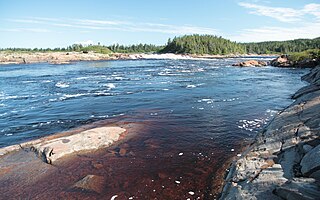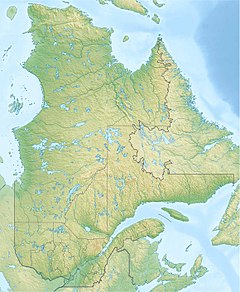Environment
A map of the ecological regions of Quebec shows the Coxipi River in sub-regions 6o-T, 6n-T and 6m-T of the east spruce/moss subdomain. About 80.6% of the watershed is forest covered, with just 3.1% covered in shrubs or grassland. 9.6% of the watershed in water and 1.2% wetlands. Annual daily mean temperatures are 0–1.2 °C (32.0–34.2 °F), ranging from −16.5 to −12.8 °C (2.3 to 9.0 °F) in January to 13.9 to 15.2 °C (57.0 to 59.4 °F) in July. Average annual precipitation is 1,005.4 to 1,122.4 millimetres (39.58 to 44.19 in). Land mammals include black bear, moose, boreal woodland caribou, wolf, lynx, beaver, North American porcupine, mink, hare and red fox.

The Magpie River is a 200 kilometres (120 mi) river in the Côte-Nord region of Quebec which flows from the Labrador Plateau to empty into the north shore of the Saint Lawrence River east of Sept-Îles, Quebec.

The Little Watshishou River is a salmon river in the east of the Côte-Nord region of Quebec, Canada.

The Nabisipi River is a salmon river in the Côte-Nord region of Quebec, Canada. It flows into the Gulf of Saint Lawrence

The Pigou River is a salmon river in the Côte-Nord region of Quebec, Canada. It empties into the Gulf of Saint Lawrence.

The Little Mécatina River is a major river in the Côte-Nord region of the provinces of Labrador and Quebec, Canada. Studies have been made to exploit the hydroelectric potential of the river, which could be around 1,200 MW from three dams. The Little Mécatina River was driven first with kayaks by Rolf Theiß and Fritz Gottensrtöter from Guetersloh, Germany.

The Coacoachou River is a river in the Côte-Nord region of Quebec, Canada.

The Véco River is a salmon river in the Côte-Nord region of Quebec, Canada, that empties into the Gulf of Saint Lawrence. It has been dammed to supply a hydroelectric power plant. The shoreline around the mouth of the river is protected as part of a federal bird sanctuary.

The Saint-Jean River is a major tributary of the north shore of the Gulf of St. Lawrence, flowing in the unorganized territory of Lac-Jérôme and in the municipality of Rivière-Saint-Jean, in the Minganie Regional County Municipality, in the administrative region of Côte-Nord, in the province of Quebec (Canada). It is considered one of the three salmon rivers on the North Shore.

The Piashti River is a salmon river in the Côte-Nord region of the province of Quebec, Canada. It empties into the Gulf of Saint Lawrence.

The Corneille River is a river in the Côte-Nord region of Quebec, Canada. It empties into the Gulf of Saint Lawrence opposite Anticosti Island.

The Sheldrake River is a river in the Côte-Nord region of Quebec, Canada. It flows into the Gulf of Saint Lawrence. There is a 25 MW hydroelectric power station on the river.

The Aguanish River is a salmon river of the Côte-Nord region of Quebec. It flows from north to south and empties into the Gulf of Saint Lawrence.

The Kegaska River is a salmon river flowing on North shore of Estuary of Saint Lawrence. It crosses the unorganized territory of Petit-Mécatina, in the Le Golfe-du-Saint-Laurent Regional County Municipality, in the administrative region in the Côte-Nord, in the province of Quebec, Canada.

The Saint-Paul River is a salmon river in the Côte-Nord region of Quebec, Canada. It empties into the Gulf of Saint Lawrence.

The Saint-Augustin River is a salmon river in the Côte-Nord region of Quebec, Canada. It empties into the Gulf of Saint Lawrence.

The Napetipi River is a salmon river in the Côte-Nord region of Quebec, Canada. It empties into the Gulf of Saint Lawrence.

The Kécarpoui River is a salmon river in the Côte-Nord region of Quebec, Canada. It flows south and empties into the Gulf of Saint Lawrence.

The Musquanousse River is a salmon river in the Côte-Nord region of Quebec, Canada. It flows south and empties into the Gulf of Saint Lawrence.

The Washicoutai River is a salmon river in the Côte-Nord region of Quebec, Canada. It flows south and empties into the Gulf of Saint Lawrence.

Lake Magpie is a lake in the Côte-Nord region of the province of Quebec, Canada. It forms the middle part of the Magpie River.
This page is based on this
Wikipedia article Text is available under the
CC BY-SA 4.0 license; additional terms may apply.
Images, videos and audio are available under their respective licenses.










